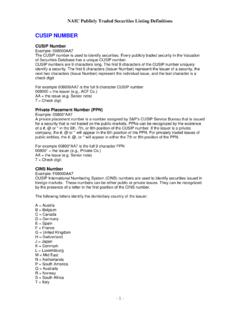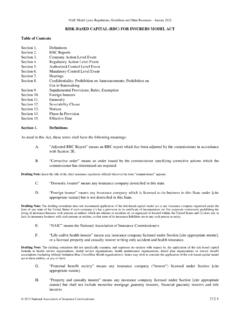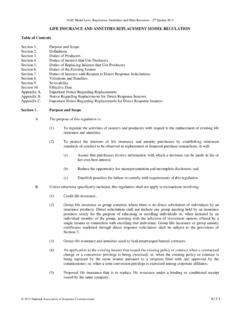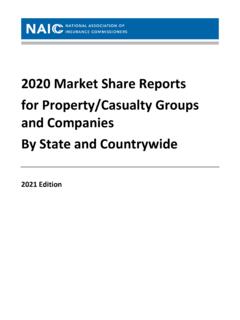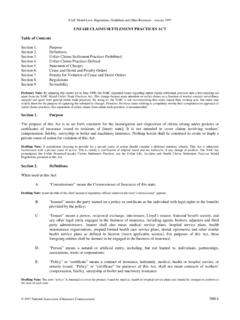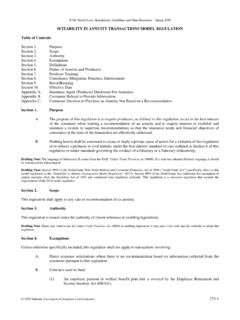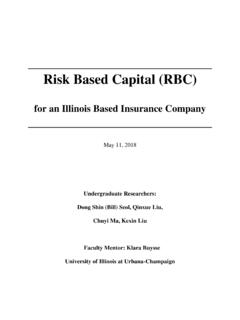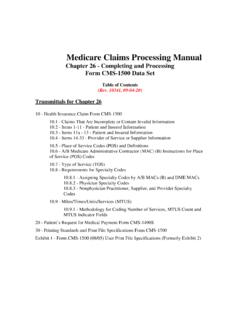Transcription of COORDINATION OF BENEFITS MODEL REGULATION Table of …
1 naic MODEL Laws, Regulations, Guidelines and Other Resources October 2013. COORDINATION OF BENEFITS MODEL REGULATION . Table of Contents Section 1. Authority Section 2. Purpose Section 3. Definitions Section 4. Applicability and Scope Section 5. Use of MODEL COB Contract Provisions Section 6. Rules for COORDINATION of BENEFITS Section 7. Procedure to be Followed by Secondary Plan to Calculate BENEFITS and Pay a Claim Section 8. Notice to Covered Persons Section 9. Miscellaneous Provisions Section 10. Effective Date for Existing Contracts Appendix A. MODEL COB Contract Provisions Appendix B. Consumer Explanatory Booklet Section 1. Authority This REGULATION is adopted and promulgated by the Commissioner of Insurance pursuant to Section [insert section] of the Insurance Code. Section 2. Purpose The purpose of this REGULATION is to: A.
2 Establish a uniform order of benefit determination under which plans pay claims;. B. Reduce duplication of BENEFITS by permitting a reduction of the BENEFITS to be paid by plans that, pursuant to rules established by this REGULATION , do not have to pay their BENEFITS first; and C. Provide greater efficiency in the processing of claims when a person is covered under more than one plan. Section 3. Definitions As used in this REGULATION , these words and terms have the following meanings, unless the context clearly indicates otherwise: A. (1) Allowable expense, except as set forth below or where a statute requires a different definition, means any health care expense, including coinsurance or copayments and without reduction for any applicable deductible, that is covered in full or in part by any of the plans covering the person.
3 (2) If a plan is advised by a covered person that all plans covering the person are high-deductible health plans and the person intends to contribute to a health savings account established in accordance with Section 223 of the Internal Revenue Code of 1986, the primary high-deductible health plan's deductible is not an allowable expense, except for any health care expense incurred that may not be subject to the deductible as described in Section 223(c)(2)(C) of the Internal Revenue Code of 1986. (3) An expense or a portion of an expense that is not covered by any of the plans is not an allowable expense. (4) Any expense that a provider by law or in accordance with a contractual agreement is prohibited from charging a covered person is not an allowable expense. (5) The following are examples of expenses that are not allowable expenses: 2013 National Association of Insurance Commissioners 120-1.
4 COORDINATION Of BENEFITS MODEL REGULATION (a) If a person is confined in a private hospital room, the difference between the cost of a semi-private room in the hospital and the private room is not an allowable expense, unless one of the plans provides coverage for private hospital room expenses. (b) If a person is covered by two (2) or more plans that compute their benefit payments on the basis of usual and customary fees or relative value schedule reimbursement or other similar reimbursement methodology, any amount charged by the provider in excess of the highest reimbursement amount for a specified benefit is not an allowable expense. (c) If a person is covered by two (2) or more plans that provide BENEFITS or services on the basis of negotiated fees, any amount in excess of the highest of the negotiated fees is not an allowable expense.
5 (d) If a person is covered by one plan that calculates its BENEFITS or services on the basis of usual and customary fees or relative value schedule reimbursement or other similar reimbursement methodology and another plan that provides its BENEFITS or services on the basis of negotiated fees, the primary plan's payment arrangement shall be the allowable expense for all plans. However, if the provider has contracted with the secondary plan to provide the benefit or service for a specific negotiated fee or payment amount that is different than the primary plan's payment arrangement and if the provider's contract permits, that negotiated fee or payment shall be the allowable expense used by the secondary plan to determine its BENEFITS . Drafting Note: Many plans negotiate rates with physicians, hospitals and other providers that are lower than the providers' usual and customary charges using other reimbursement methodology, such as relative value schedule reimbursement or other similar reimbursement methodology.
6 Because the provider has agreed to accept the negotiated payment, less any required deductibles, coinsurance or copayments for the services, COB is not to be used to increase the provider payment. Conversely, because the provider has agreed to accept the negotiated payment, less any required deductibles, coinsurance or copayments for the services, COB is not to be used to decrease the amount the provider has negotiated to accept in payment for the services. This provision limits COB. allowable expense to the negotiated rate. Plans should include provisions in their provider contracts to account for payments under COORDINATION of BENEFITS . (6) The definition of allowable expense may exclude certain types of coverage or BENEFITS such as dental care, vision care, prescription drug or hearing aids. A plan that limits the application of COB to certain coverages or BENEFITS may limit the definition of allowable expense in its contract to expenses that are similar to the expenses that it provides.
7 When COB is restricted to specific coverages or BENEFITS in a contract, the definition of allowable expense shall include similar expenses to which COB applies. Drafting Note: The intent of this provision is to permit plans to limit the extent of COORDINATION to plans with similar types of coverages or BENEFITS , , COORDINATION of health plans with health plans or dental plans with dental plans, etc. (7) When a plan provides BENEFITS in the form of services, the reasonable cash value of each service will be considered an allowable expense and a benefit paid. (8) The amount of the reduction may be excluded from allowable expense when a covered person's BENEFITS are reduced under a primary plan: (a) Because the covered person does not comply with the plan provisions concerning second surgical opinions or precertification of admissions or services; or (b) Because the covered person has a lower benefit because the covered person did not use a preferred provider.
8 B. Birthday refers only to month and day in a calendar year and does not include the year in which the individual is born. 120-2 2013 National Association of Insurance Commissioners naic MODEL Laws, Regulations, Guidelines and Other Resources October 2013. C. Claim means a request that BENEFITS of a plan be provided or paid. The BENEFITS claimed may be in the form of: (1) Services (including supplies);. (2) Payment for all or a portion of the expenses incurred;. (3) A combination of Paragraphs (1) and (2); or (4) An indemnification. D. Closed panel plan means a plan that provides health BENEFITS to covered persons primarily in the form of services through a panel of providers that have contracted with or are employed by the plan, and that excludes BENEFITS for services provided by other providers, except in cases of emergency or referral by a panel member.
9 E. Consolidated Omnibus Budget Reconciliation Act of 1985 or COBRA means coverage provided under a right of continuation pursuant to federal law. F. COORDINATION of BENEFITS or COB means a provision establishing an order in which plans pay their claims, and permitting secondary plans to reduce their BENEFITS so that the combined BENEFITS of all plans do not exceed total allowable expenses. G. Custodial parent means: (1) The parent awarded custody of a child by a court decree; or (2) In the absence of a court decree, the parent with whom the child resides more than one half of the calendar year without regard to any temporary visitation. H. (1) Group-type contract means a contract that is not available to the general public and is obtained and maintained only because of membership in or a connection with a particular organization or group, including blanket coverage.
10 (2) Group-type contract does not include an individually underwritten and issued guaranteed renewable policy even if the policy is purchased through payroll deduction at a premium savings to the insured since the insured would have the right to maintain or renew the policy independently of continued employment with the employer. I. High-deductible health plan has the meaning given the term under Section 223 of the Internal Revenue Code of 1986, as amended by the Medicare Prescription Drug, Improvement and Modernization Act of 2003. J. (1) Hospital indemnity BENEFITS means BENEFITS not related to expenses incurred. (2) Hospital indemnity BENEFITS does not include reimbursement-type BENEFITS even if they are designed or administered to give the insured the right to elect indemnity-type BENEFITS at the time of claim.
